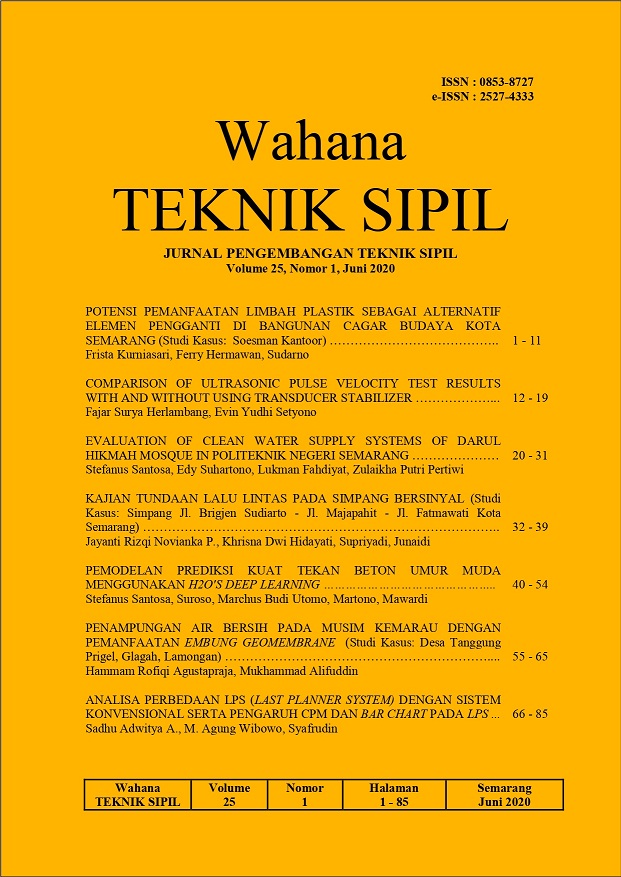ANALISA PERBEDAAN LPS (LAST PLANNER SYSTEM) DENGAN SISTEM KONVENSIONAL SERTA PENGARUH CPM DAN BAR CHART PADA LPS
DOI:
https://doi.org/10.32497/wahanats.v25i1.1919Keywords:
Bar Chart, CPM (critical path method), Last Panner SystemAbstract
Two generally method / tools which used in project construction management system in Indonesia and the name are CPM (critical part method) or network planning and Bar Chart. The system used general method called conventional management system. Nowadays, was appeared one of a new system which seldom to applied in Indonesia, it is called LPS (last planner system). This research, researcher doing analyzed the differences between LPS and conventional management system. The result which obtained in this research are LPS dominated to accentuates team collaborative in the scheduling planning, resource allocation, control and enhance of work productivity, issue solved, regularly scheduling planning. Conventional management system more rely on the way CPM and Bar Chart working in that system with project manager decision. Planning of the schedule in this system doing by scheduling team. rescheduling in this system is not routine, it”™s depend by construction progress. CPM and Bar Chart methods is influence on LPS. The both of methods was appeared in master scheduling, look a head scheduling, weekly work planning, shielding production, workable back log, percent plan completed and reliable promise processReferences
Ariyanto, A., 2010, Eksplorasi Metode
Bar Chart, CPM, PDM, Pert,
Line Of Balance Dan Time
Chainage Diagram Dalam
Penjadwalan Proyek Konstruksi.
Pasca Sarjana Teknik Sipil.
Universitas Diponegoro
Ballard, H. G., 2000, The Last Planner
System of Production Control.
Journal of Chemical
Information and Modeling, 53
(9), 1689”“1699. https:
//doi.org/10.1017/
CBO9781107415324.004
Ballard, H. G., Tommelein, I., Hamzeh,
F., 2007, The Last Planner
Production Workbook-
Improving Reliability in
Planning and Workflow. Lean
Construction Institute
Direktorat Riset dan Pengabdian
Masyarakat Universitas
Indonesia, 2007, Kajian Aspek
Kemasyarakatan DI Dalam
Pengembangan Infrastruktur
Indonesia, Universitas Indonesia
Febri, Triwibowo, Imron, Wijaya, R.,
, Perbandingan metode
Penjadwalan pada Proyek
Konstruksi yang bersifat lilier
(Studi kasus menggunakan
metode Bar Chart, Network
Planning dan Time Chainage Diagram). Undergraduate
thesis, Diponegoro University
Fernandez-Solis, J. L., Porwal, V.,
Lavy, S., Shafaat, A.,
Rybkowski, Z. K., Son, K.,
Lagoo, N., 2013, Survey of
Motivations, Benefits, and
Implementation Challenges of
Last Planner System Users.
Journal of Construction
Engineering and Management,
(4), 354”“360
Hamzeh, R. F., Saab, I., Iris, D.,
Tommelein & Ballard H. G.,
, Understanding the role of
“task anticipated” in look a head
planning though simpulation.
Automation in construction.
Science Direct
Heery, 2015, An Introduction Do Pull
Planning. IFMA
Human, A. D., & Zuldi, S., 2018,
Penilaian Kesiapan Praktisi
Indonesia Terhadap Last
Planner System. Teknik Sipil.
Universitas Diponegoro
Husen, A., 2011, Manajemen Proyek,
Penerbit Andi, Yogyakarta
Mudzakir, C. A., Setiawan, A.,
Wibowo, A. M., Khasani, R. R.,
, Evaluasi Waste Dan
Implementasi Lean
Construction (Studi Kasus:
Proyek Pembangunan Gedung
Serbaguna Taruna Politeknik
Ilmu Pelayaran Semarang).
Jurnal Karya Teknik Sipil,
Volume 6, Nomor 2, Tahun
, Halaman 145 ”“ 158
Online di: http://ejournals1.
undip.ac.id/index.php/jkts
Pellicer, E., Cerveró, F., Lozano, A.,
Ponz-Tienda, L. J., 2015, THE
Last Planner System Of
Construction Planning And
Control As A Teaching And
Learning Tool. Research Gate
Ramadhani, R. I., 2017, Koordinasi
Dalam Pembangunan
Infrastruktur Dan
Pengembangan Sumber daya
Manusia Oleh PT Swakarsa
Sinar Sentosa Di Desa Muara
Wahau Kecamatan Muara
Wahau Kabupaten Kutai Timur.
eJournal Pemerintahan
Integratif, 2017, 5 (1): 148-158
Siswanto, S., Suyanto, 2017,
Metodologi Penelitian
Kombinasi Kualitatif-
Kuantitatif Kedokteran dan
Kesehatan. BOSSSCRIPT.
Klaten Selatan
PT. Wijaya Karya Tbk., 2015, Proyek
Rehabilitasi Saluran induk dan
Seukunder Kelambu Kiri,
BKKi.1-BKKi.15. Demak, Jawa
Tengah
Downloads
Published
Issue
Section
License
Authors who publish with this journal agree to the following terms:Authors retain copyright and grant the journal right of first publication with the work simultaneously licensed under a Creative Commons Attribution License that allows others to share the work with an acknowledgement of the work's authorship and initial publication in this journal.
Authors are able to enter into separate, additional contractual arrangements for the non-exclusive distribution of the journal's published version of the work (e.g., post it to an institutional repository or publish it in a book), with an acknowledgement of its initial publication in this journal.
Authors are permitted and encouraged to post their work online (e.g., in institutional repositories or on their website) prior to and during the submission process, as it can lead to productive exchanges, as well as earlier and greater citation of published work (See The Effect of Open Access).






